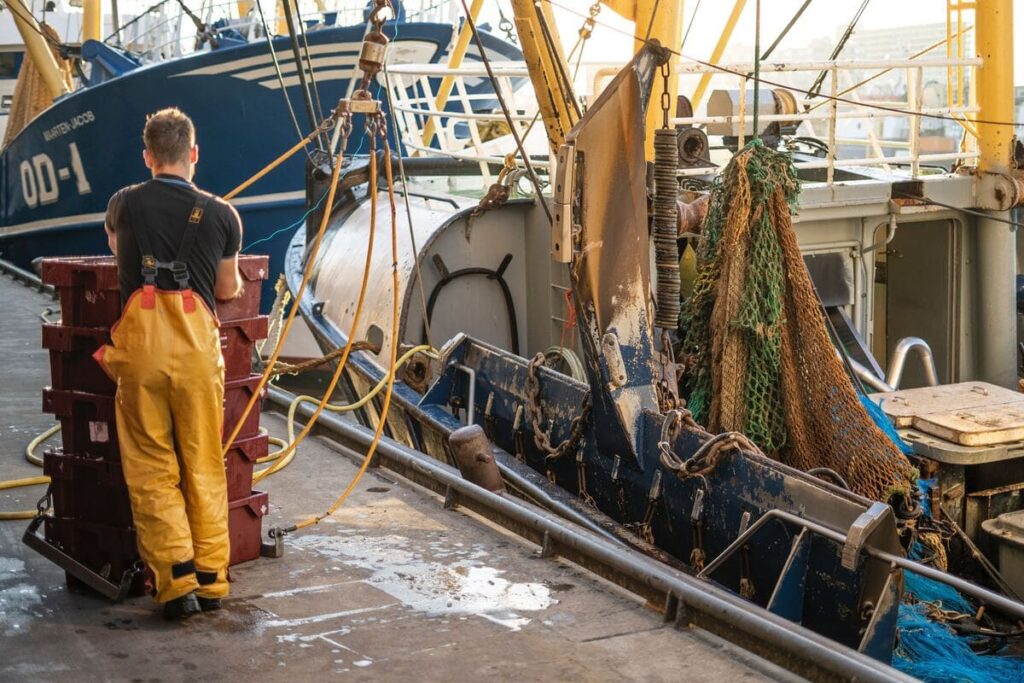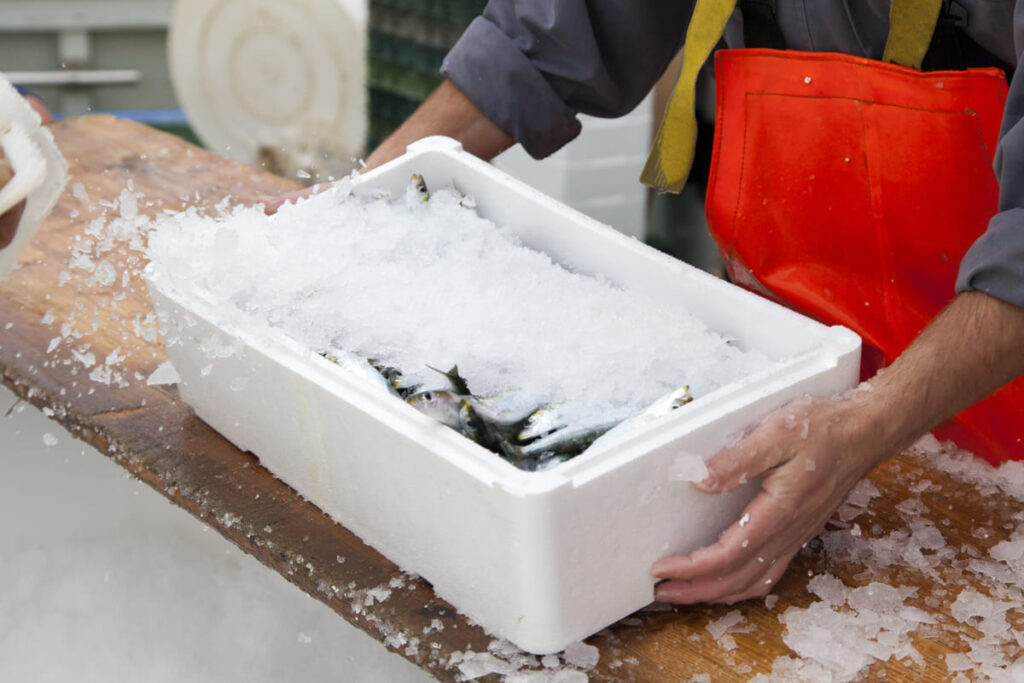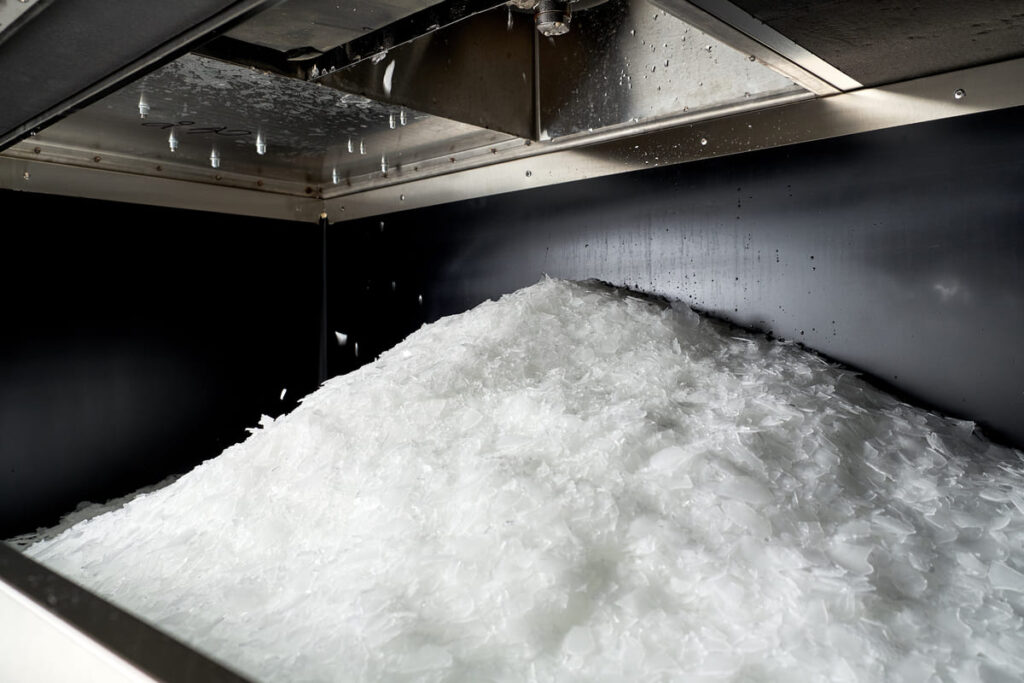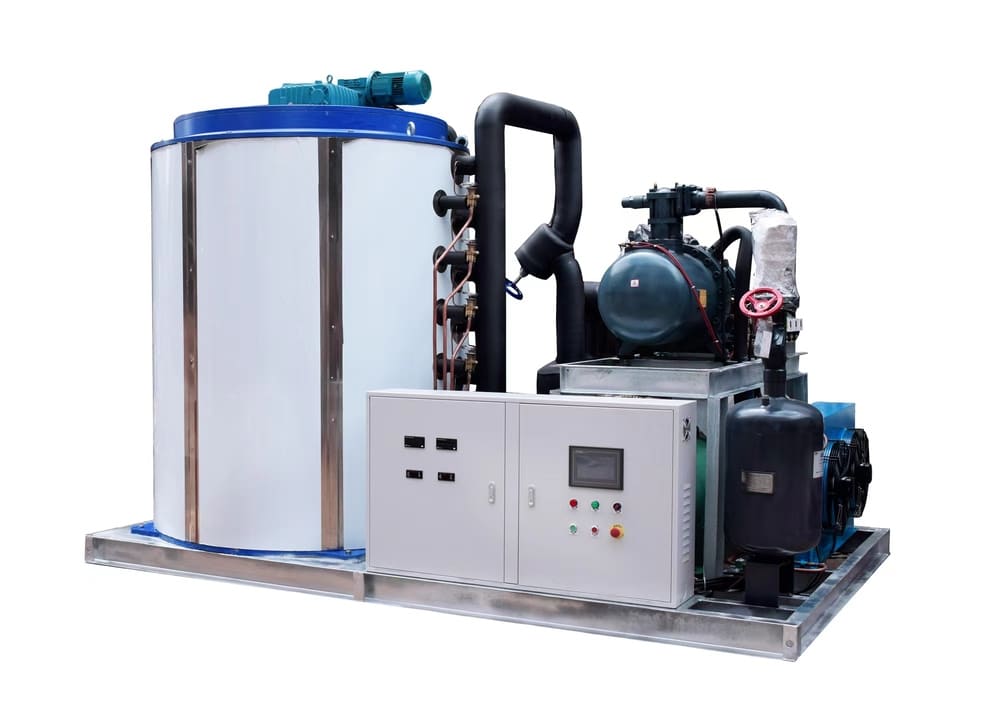When selecting an ice machine capacity for your vessel size, there are various elements to be taken into account. The importance of having an adequate ice production system cannot be overstated, especially in industries such as fishery, seafood distribution, chilled and frozen meat import/export, and food processing plants.
In this blog post on how to choose an appropriate ice machine capacity for your vessel size, we will delve into various aspects you must consider before making a decision. We will begin by discussing methods to estimate your vessel’s ice requirements based on its specific needs and operational conditions.

Next, we will examine the relationship between the size of your vessel and the ideal capacities of available ice machines. Additionally, we will touch upon budgetary considerations while choosing an optimal solution for maintaining ideal temperatures during storage and transportation processes.
Lastly, seeking professional advice from experienced ice machine manufacturers can help ensure that you make well-informed decisions when it comes to maximizing efficiency without compromising quality or safety standards. Stay tuned as we explore these crucial elements in detail throughout this comprehensive guide on how to choose an appropriate ice machine capacity for your vessel size.
Estimate Your Vessel’s Ice Requirements
Before buying an ice machine for your boat, you need to estimate the amount of ice you’ll need to store and use onboard. Estimating the amount of ice you’ll need for your boat necessitates taking into account several elements, including what type of items are being held or shipped, how long they will be stored or moved, and any precise temperature demands.
To determine your vessel’s ice requirements:
- Analyze your product needs: Different products need different amounts of ice. For example, fishery applications may need more ice than chilled meat importers due to differences in ideal temperatures and spoilage rates.
- Determine storage duration: The longer a product must be stored or transported, the more ice it will need. Consider how long your cargo typically remains onboard before reaching its destination.
- Evaluate temperature requirements: Some products have strict temperature guidelines that require increased levels of icing. Research these guidelines for each type of cargo you handle regularly.
Also, consider peak periods when calculating your vessel’s maximum capacity for storing and using ice. During busy seasons or high-demand times, you may need additional supplies beyond what would normally suffice during slower periods.
Ice Production Rate vs Storage Capacity
When estimating overall usage needs based on cargo types and durations aboard ship vessels, consider both your desired production rate and available space within your cold-storage areas. A higher output might seem appealing initially, but if there isn’t enough room on-site, excess materials could end up wasted, and unused, potentially leading owners/operators down a path toward inefficiency and lost profits long term.
Once you’ve estimated your vessel’s ice requirements, it’s time to consider the size of your boat and how much space is available for an ice machine. Once you’ve calculated the ice needs of your vessel, it’s time to assess its size and available space for an ice machine to ensure a model with suitable capacity and dimensions is chosen. Keep in mind that some ice machines also require additional components, such as ice bins, which may affect overall sizing considerations.
Before purchasing an ice machine for your boat, it is important to estimate the amount of ice you’ll need based on product needs, storage duration, and temperature requirements. When considering overall usage needs, both desired production rate and available space within cold-storage areas should be taken into account to avoid inefficiency and lost profits in the long term. It’s also crucial to consider the size of your vessel and how much space is available for an appropriate capacity ice machine with dimensions that suit your specific needs.
Consider the Size of Your Vessel
It’s important to ensure that the size of your ice maker won’t take up too much room or be an awkward fit in the designated spot. That’s why it’s essential to measure the dimensions of your boat and identify a suitable location for installation.
When it comes to fishing vessels, a compact yet high-capacity ice machine is ideal for preserving catch during long trips at sea. Hiceay offers a range of commercial flake and tube ice machines designed specifically for marine applications. For seafood distributors, industrial-grade flake or tube ice makers from Hiceay can ensure efficient cooling while occupying minimal space on the deck.
If you’re involved in chilled/frozen meat transportation via ships or barges, selecting an appropriate capacity unit becomes even more critical due to strict temperature control requirements imposed by food safety regulations worldwide. Consult with professionals at Hiceay about custom-built solutions tailored specifically towards these unique demands.

And if you’re operating a floating food processing plant, it’s crucial to have a reliable and efficient ice machine on board. Hiceay offers a range of industrial ice machines that can cater to the needs of such facilities.
Once you’ve determined your vessel size and available space for an ice machine, consider factors like power supply availability and water source accessibility. This will help you narrow down your options further when selecting the most suitable Hiceay ice machine model for your specific requirements.
Don’t forget to factor in any potential future expansions or changes in operations that may affect your vessel’s cooling needs. Anticipating potential changes to your vessel’s cooling needs ahead of time can ensure that you make the most suitable choice when selecting an Hiceay ice machine model.
Choosing the right ice machine for your vessel is crucial and it all starts with considering the size of your boat. Hiceay offers a range of commercial flake and tube ice machines designed specifically for marine applications, so consult with professionals at Hiceay about custom-built solutions tailored to unique demands. Don’t forget to factor in any potential future expansions or changes in operations that may affect your vessel’s cooling needs when selecting an appropriate capacity unit.
Choose the Right Ice Machine Capacity for Your Vessel
Choosing the right ice machine capacity for your vessel is crucial to ensure you have enough ice without wasting space or energy. Here are some factors to consider:
Determine Your Daily Ice Production Needs
First, determine how much ice you need per day based on your vessel’s activities and storage requirements. A fishing boat may need more ice than a seafood distributor to keep its catch fresh.
Consider the Type of Ice Needed
The type of ice needed can also affect which capacity is most suitable. Flake ice machines are ideal for preserving fishery products, while tube or nugget-style ice makers might be preferable in food processing plants.
Think About Space Constraints on Your Vessel
Consider any physical limitations that could impact where an ice maker can be installed aboard your ship, including available floor space, ceiling height restrictions, ventilation requirements, and access points for maintenance purposes.
- Compact models: For small boats, look into compact commercial-grade units with lower capacities but still capable of meeting daily production demands.
- Larger units: For larger vessels, industrial-scale systems offering higher output rates might be necessary to accommodate substantial quantities of perishable goods.
Choose an Energy-Efficient Model
Energy efficiency is critical when choosing an ice machine capacity, as it can significantly impact your vessel’s operating costs. Opt for models with Energy Star certification or other energy-saving features to reduce power consumption without sacrificing performance.
Also, take into account the cost of water needed for ice production, particularly if you operate in areas where freshwater resources are scarce or expensive. Some icemakers come equipped with built-in water-saving technologies that can help minimize waste and lower expenses over time.
Prioritize Reliability and Durability
Finally, prioritize reliability and durability when selecting an appropriate ice machine capacity for your vessel size. High-quality machines like those from Hiceay are designed to withstand harsh marine environments while delivering consistent performance day after day – ensuring a long-lasting investment that will serve your needs well into the future.

Choosing the right ice machine capacity for your vessel is crucial to ensure you have enough ice without wasting space or energy. Consider factors such as daily production needs, type of ice needed, space constraints on your vessel, energy efficiency, and reliability/durability when selecting an appropriate ice machine capacity for your vessel size. Opting for high-quality machines like those from Hiceay can deliver consistent performance day after day ensuring a long-lasting investment that will serve your needs well into the future.
4. Consider Your Budget
Choosing an ice machine for your vessel? Don’t forget to consider your budget. Ice machines come in various capacities and price ranges, so it’s crucial to find one that fits within your financial constraints. To make an informed decision, compare different models and their respective costs.
Determine your budget for an ice machine before making a decision. Consider that higher-capacity units could require more money initially, but may result in savings eventually with their enhanced productivity and fewer demands for extra equipment or components.
Research Different Brands
- Reputable Manufacturers: Look into premium quality flake ice machines and tube ice machines designed specifically for commercial and industrial applications from Hiceay and other reputable manufacturers.
Analyze Features
- Energy Efficiency: Evaluate the features of each model, such as energy efficiency, durability, and maintenance requirements, which can impact long-term operating costs.
- Financing Options: Inquire about financing options or payment plans to help ease the initial investment burden on customers purchasing new equipment.
Beyond the initial purchase price, other factors could affect the overall cost-effectiveness of your ice machine:
Maintenance Costs
- Frequency of Maintenance: The frequency of required maintenance can vary between different types of ice machines. Regular upkeep helps ensure optimal performance while reducing potential downtime caused by malfunctions or breakdowns.
Energy Consumption
- Electricity Consumption: Different models consume varying amounts of electricity during operation. Energy-efficient machines may have a higher upfront cost but can save you money in the long run by reducing electricity bills.
Ice Storage and Transportation
- Storage and Transportation: Depending on your vessel’s size and ice requirements, additional costs might be incurred for proper storage and transportation of the ice produced. This could include insulated containers or refrigerated compartments to maintain optimal temperatures during transit.
When considering an appropriate ice machine capacity for your vessel size, evaluate not only the initial purchase price but also any ongoing operating expenses associated with maintenance, energy consumption, and storage/transportation needs.
By doing so, you’ll be better equipped to make an informed decision that aligns with both your operational requirements and financial constraints.
For guidance in determining the most cost-efficient option for your unique situation, seek advice from experts experienced in this area. Their expertise can prove invaluable as you navigate through this important decision-making process.
When choosing an ice machine for your vessel, it’s important to consider your budget and research different brands. Analyze features such as energy efficiency and maintenance requirements, and factor in ongoing expenses like electricity consumption and storage/transportation needs. Consulting with professionals can help you make a cost-effective decision that aligns with both your operational requirements and financial constraints.
5. Get Professional Advice
It’s critical to seek the counsel of experts who can offer helpful insights into elements that could influence your choice.
Start with Research
Begin by researching online resources like Hiceay’s website, where you can find detailed information about their range of premium quality commercial and industrial flake ice machines and tube ice machines. Compare product specs to pinpoint the perfect model for your needs – size, power draw, and other features can all be taken into account.
Reach Out to Experts
It’s also essential to reach out directly to professionals who have experience working with similar vessels in the same industry sector as yours. They will likely have firsthand knowledge of which models perform best under specific conditions and what potential issues might arise during operation.
- Contact Manufacturers: Reach out directly to reputable manufacturers like Hiceay by submitting an inquiry through their contact form or calling them up for personalized advice on choosing an appropriate ice machine capacity for your vessel size.
- Seek Recommendations from Peers: Consult fellow business owners within your industry who operate similar-sized vessels – they may offer helpful recommendations based on their own experiences using different types of ice machines.
- Hire a Consultant: If you’re unsure about making this decision independently or need more specialized guidance tailored specifically to your unique situation – consider hiring a consultant specializing in marine refrigeration systems design & installation services. Their expertise could prove invaluable when determining which ice machine model is best suited for your vessel’s requirements.
Consider Other Important Factors
Remember to pick an ice machine that will not only satisfy your present needs but can also accommodate any future growth. In addition to seeking professional advice, don’t forget about other important factors like energy efficiency, ease of maintenance, warranty coverage, and overall reliability when comparing different models.
Investing time upfront in researching these aspects will pay off in the long run by ensuring you choose an ice machine that provides optimal performance while minimizing operating costs over its lifespan.
Choosing the right ice machine for your vessel can be overwhelming, but it’s important to consider factors such as capacity, dimensions, and power consumption and seek professional advice from experts. Research online resources like Hiceay’s website or reach out directly to reputable manufacturers and fellow business owners within your industry who operate similar-sized vessels. Remember to also consider other important factors like energy efficiency, ease of maintenance, warranty coverage, and overall reliability when comparing different models.
FAQs in Relation to How to Choose an Appropriate Ice Machine Capacity for Your Vessel Size
How big should my ice machine be?
Determine the size of your ice machine based on your vessel’s size and daily ice requirements, taking into account storage, processing, and product preservation needs.
How do I choose an ice machine?
Consider vessel size, required capacity, budget constraints, and energy efficiency when selecting an ice machine, and seek expert advice from Hiceay.
How is ice machine capacity stated?
Ice machine capacity is typically stated in pounds per 24 hours (lbs/24hrs) or kilograms per day (kg/day), indicating the amount of ice it can produce within that time frame.
How do I choose a commercial ice maker?
- Determine your business’s daily need for both quantity and type of ice.
- Evaluate available space for installation.
- Select between air-cooled or water-cooled units based on environmental conditions.
- Consider budget constraints, including purchase price and operating costs.
- For more information, check out this guide on choosing a commercial ice maker.
Conclusion
Don’t let your vessel run out of ice – choose the right ice machine capacity based on your needs and vessel size. Estimate your ice requirements and consider your budget before making a decision.
Too little or too much ice can cause problems, so it’s important to get professional advice if you’re unsure. With the right amount of ice on board, you can keep your catch fresh and maintain food safety standards.
Don’t take chances with your ice supply – make a well-informed decision and enjoy your time on the water.



